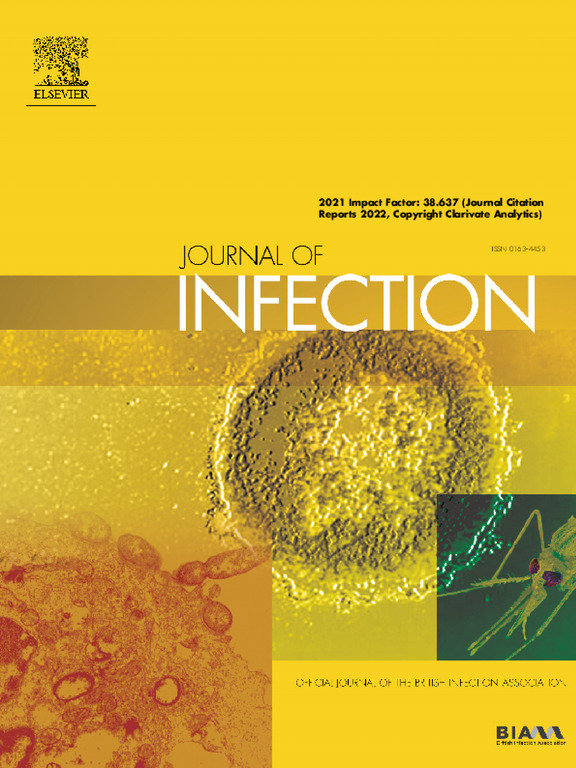荷兰2022/2023年呼吸道季节SARS-CoV-2与呼吸道病毒共感染动态
IF 14.3
1区 医学
Q1 INFECTIOUS DISEASES
引用次数: 0
摘要
目的:评价SARS-CoV-2合并感染对疾病严重程度的影响。方法:在荷兰进行的一项大型参与性监测研究中,我们收集了2022/2023呼吸道季节有症状人群的症状数据和鼻咽喉样本,并对包括SARS-CoV-2在内的18种呼吸道病毒进行了检测。我们比较了报告的健康状况、症状和患单呼吸道病毒感染或合并感染SARS-CoV-2和另一种呼吸道病毒的几率。结果:共纳入4655份样本,其中22% (n= 1017)呈SARS-CoV-2阳性。其中11% (n=116)的第二呼吸道病毒检测呈阳性。在SARS-CoV-2阳性参与者中,最常见的合并感染是鼻病毒(59%;N =69),季节性冠状病毒(15%;N =17)和腺病毒(7%;n = 8)。与SARS-CoV-2单一感染的参与者相比,同时感染这三种病毒之一的参与者没有报告更严重的疾病。SARS-CoV-2合并季节性冠状病毒或鼻病毒感染的几率低于各自非SARS-CoV-2单一感染的几率(or: 0.16, CI 95%: 0.10 - 0.24;Or: 0.21 ci 95%: 0.17 - 0.26;分别)。结论:SARS-CoV-2与鼻病毒、季节性冠状病毒和腺病毒合并感染在普通人群中常见,但与SARS-CoV-2单一感染相比,其病情并不严重。此外,我们发现了病毒间与鼻病毒和季节性冠状病毒相互作用的迹象,可能降低了合并感染的风险。本文章由计算机程序翻译,如有差异,请以英文原文为准。
Co-infection dynamics of SARS-CoV-2 and respiratory viruses in the 2022/2023 respiratory season in the Netherlands
Objectives
Evaluation of the presence and effect of SARS-CoV-2 co-infections on disease severity.
Methods
We collected both symptom data and nose- and throat samples from symptomatic people during the 2022/2023 respiratory season in a large participatory surveillance study in the Netherlands, and tested these for 18 respiratory viruses, including SARS-CoV-2. We compared reported health status, symptoms and odds of having a single respiratory viral infection or co-infection with SARS-CoV-2 and another respiratory virus.
Results
In total, 4655 samples were included with 22% (n=1017) testing SARS-CoV-2 positive. Of these 11% (n=116) also tested positive for a second respiratory virus. The most frequently occurring co-infections in SARS-CoV-2 positive participants were with rhinovirus (59%; n=69), seasonal coronaviruses (15%; n=17), and adenovirus (7%; n=8). Participants with a co-infection with one of these three viruses did not report more severe disease compared to those with a SARS-CoV-2 mono-infection. The odds of experiencing SARS-CoV-2 co-infection with seasonal coronavirus or rhinovirus were lower compared to the odds of the respective non-SARS-CoV-2 mono-infection (OR: 0.16, CI 95%: 0.10 – 0.24; OR: 0.21 CI 95%: 0.17 – 0.26; respectively).
Conclusions
SARS-CoV-2 co-infections with rhinovirus, seasonal coronavirus, and adenovirus are frequently observed in the general population, but are not associated with more severe disease compared to SARS-CoV-2 mono-infections. Furthermore, we found indications for inter-virus interaction with rhinovirus and seasonal coronavirus, possibly decreasing the risk of co-infection.
求助全文
通过发布文献求助,成功后即可免费获取论文全文。
去求助
来源期刊

Journal of Infection
医学-传染病学
CiteScore
45.90
自引率
3.20%
发文量
475
审稿时长
16 days
期刊介绍:
The Journal of Infection publishes original papers on all aspects of infection - clinical, microbiological and epidemiological. The Journal seeks to bring together knowledge from all specialties involved in infection research and clinical practice, and present the best work in the ever-changing field of infection.
Each issue brings you Editorials that describe current or controversial topics of interest, high quality Reviews to keep you in touch with the latest developments in specific fields of interest, an Epidemiology section reporting studies in the hospital and the general community, and a lively correspondence section.
 求助内容:
求助内容: 应助结果提醒方式:
应助结果提醒方式:


